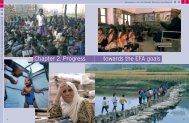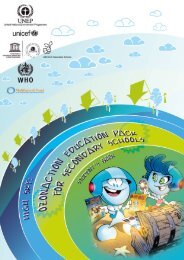Financing Education / pdf - Unesco
Financing Education / pdf - Unesco
Financing Education / pdf - Unesco
Create successful ePaper yourself
Turn your PDF publications into a flip-book with our unique Google optimized e-Paper software.
2<br />
0<br />
8<br />
0<br />
CHAPTER 4<br />
<strong>Education</strong> for All Global Monitoring Report<br />
Nine bilateral<br />
donors put over<br />
20% of their aid<br />
in the form of<br />
sector support<br />
Not all donors have adopted the more<br />
programmatic aid modalities equally. Again, the<br />
data are approximate and depend on how donors<br />
report aid, but the multilateral agencies appear<br />
to have moved further than the bilateral donors<br />
as a group: for the former, 38% of their education<br />
aid in 2004–2005 was in the form of sector support,<br />
compared to only 14% for the latter. Nevertheless,<br />
nine bilateral donors put over 20% of their aid in<br />
this form, and for Canada, Denmark, Finland,<br />
Norway and Sweden the share was over 40%<br />
(OECD-DAC, 2007c).<br />
Some implications of the new aid modalities<br />
for education<br />
The move to more programme lending is not<br />
simply a change in financing modalities. It is<br />
part of a broader movement to improve the<br />
harmonization and alignment of efforts between<br />
donors and between governments and donors.<br />
This does not occur automatically. The appropriate<br />
conditions must exist within countries for it to<br />
be possible to move away from a project focus<br />
towards more programmatic support around<br />
the sector-wide reforms called for in the Dakar<br />
Framework for Action. While there is broad<br />
support in principle among donors for the change<br />
in focus, there are also differing interpretations<br />
of the implications and of the desirable speed for<br />
adopting the new modalities. Developing country<br />
governments have shown similar differences in<br />
viewpoint.<br />
In 2005, the Global Campaign for <strong>Education</strong><br />
named the Swedish International Development<br />
Cooperation Agency (Sida) the premier donor to<br />
education in terms of supporting the countries<br />
with the largest needs and using local plans and<br />
systems as its starting point. An examination of<br />
Sida’s experiences in shifting towards more<br />
programmatic support for aid to basic education<br />
is, therefore, particularly useful in highlighting<br />
some of the challenges. Sida’s current annual<br />
report describes the situation in each of the fifteen<br />
countries it supports in basic education, in terms<br />
of type of funding (project, sector programme, or<br />
direct budget support), the degree of interaction<br />
with other donors and the relationship with the<br />
government, including its ability to meet the<br />
requirements of a more programmatic approach<br />
(Sida, 2007). Only in Bolivia, Honduras, Mali,<br />
Mozambique, Rwanda and the United Republic<br />
of Tanzania does Sida provide aid as sectoral<br />
or general budget support. In Bangladesh and<br />
Cambodia, specific activities within sector<br />
programmes are supported. In the remaining<br />
seven countries, support is still provided for<br />
individual projects, though in some there are<br />
discussions with other donors to improve<br />
coordination and harmonization.<br />
The strong involvement of governments in sector<br />
programmes in the six countries receiving Sida<br />
budget support is made clear, but in several of the<br />
other countries there are said to be low levels of<br />
government ‘ownership’ of donor-supported<br />
activities and a severe lack of management and<br />
planning capacity and accountability. In the Lao<br />
People’s Democratic Republic, there are differing<br />
views within government on the desirability of a<br />
sector-wide approach. The lesson here is that even<br />
when the donor agency is fully committed to<br />
sector-wide programmes and is joined by likeminded<br />
donors, this approach does not work<br />
automatically – it still requires strong government<br />
implementation capacity and support.<br />
The Netherlands has also been at the forefront<br />
of introducing changes in aid modalities. It has<br />
used budget support and SWAps as the organizing<br />
principle for bilateral aid since 1998, with<br />
education as a priority sector (Riddell, 2007a). In<br />
assessing whether countries are ready for such an<br />
approach, the requirements are (a) an effective<br />
poverty reduction strategy, which must translate<br />
the Millennium Development Goals (MDGs) into<br />
national policies and allow for partnerships,<br />
including with civil society; (b) effective policy<br />
dialogue with the government on improving<br />
governance and reducing poverty; and (c) a<br />
results-based approach with clearly defined<br />
progress indicators for institutional and policy<br />
reforms. A recent evaluation of the changed focus<br />
since 1998 concluded that:<br />
the rapid adoption of a uniform approach in the<br />
introduction of SWAps outstripped the capacity<br />
of recipient-country ministries, and in most<br />
countries the institutional infrastructure was<br />
inadequate to meet such a drastic change;<br />
in most cases, the expected increase in<br />
ownership in the recipient countries did not<br />
materialize;<br />
in most sectors, the recipient governments have<br />
great difficulty in effectively reaching the poor<br />
(Netherlands Ministry of Foreign Affairs, 2006).<br />
166

















